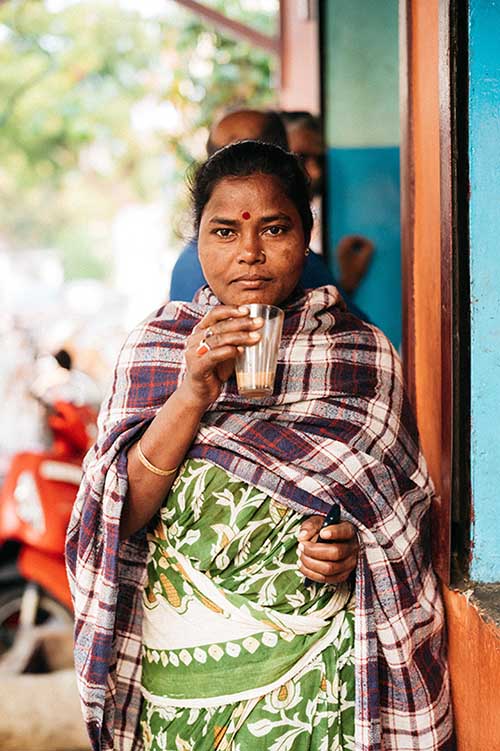If you’ve read the third edition of our magazine, Original Traveller, you’ll know we’re big into Kintsugi Travel (and, if you haven’t, here’s the link to read it). In a world faced with Instagram-fuelled overtourism and exponentially expanding flight routes, we’re on a mission to repair travel – with gold lacquer and all. And highlighting sustainable tourism in India seems like a good place to start. As the seventh-largest country in the world, home to a staggering 1.4 billion people, India is no stranger to overcrowding or philanthropic relief. But it's also a country steeped in spirituality and tradition, festivals and architecture and otherworldly landscapes. Read on to discover how you can make a positive difference during a holiday to India.
Undertourism
There’s no doubt that India is a victim of overtourism. With 6.4 million tourists each year, you’ll find it near impossible to find a square foot of the country – especially its cities – that isn’t shared with a dozen others. But that’s not to say they don’t exist. This is where our idea of Undertourism comes in. It’s all about striking out against the tourist trail and seeking alternative and authentic experiences far from the heaving hotspots. And fortunately, thanks to its size, India isn’t short on them. Swap queues at the Taj Mahal for private Bagru block painting in Jaipur and 4x4s full of snap-happy tourists in Ranthambore National Park for tranquil tours of Hemis National Park in Ladakh, home to the elusive snow leopard.
Philantourism
Philantourism, a combination of philanthropy and tourism, is the act of choosing a holiday in order to support a down-on-its-luck destination. And you don’t even need to do anything when you get there. Simply head to the country in question, spend your money on dinners out in local restaurants, nights in bucolic community lodges and souvenirs from stalls, markets and boutiques. Just like that, you’re contributing to sustainable tourism. In India, Philantourism can mean travelling to Little Andaman (spoiler alert: it isn’t that little). It’s the least-visited island of the Andaman archipelago and is still bouncing back after being ravaged by the 2004 tsunami, but continues to be a truly lovely destination with pristine beaches and an array of locally-run guesthouses. Or it can mean bypassing the popular states of Rajasthan and Maharashtra for neighbouring Gujarat, home to a significant portion of the country’s Jain population and some of the most spectacular temples in the world.

Image by Lucy Laucht
Community-based tourism
It wouldn’t be right to discuss sustainable tourism in India without mentioning community-based tourism. By taking part in tourism experiences and staying in accommodations run by local communities, you’re guaranteeing that your money stays local (rather than ending up offshore). Take Chambal Safari, for example. A mere hour's drive from the Taj Mahal, this charming locally-owned eco-retreat combines home comforts with conservation. It has planted huge numbers of indigenous trees and shrubs, attracting over 198 bird, reptile and mammal species back to the area; has a designated Wildlife Conservation Week to generate interest and awareness among local school children; and hires the majority of its team from the local community. Special mention should go to the fact all its produce, which is harvested from the lodge’s farm, and all activities, including exploratory interactive walks, are conducted by locals that know the land like the back of their hand. And think, this is just one example…

Image by Gemma Cagnacci
Indigenous tourism
According to the World Bank, ‘Indigenous people own, occupy, or use a quarter of the world’s surface area’ and ‘safeguard 80 per cent of the world’s remaining biodiversity’. So, it’s a no-brainer for us to develop itineraries and relationships that focus on these natural guardians. Tribal people (or Adivasi as they are known in the country) represent eight per cent of India’s total population and come with a whole host of rituals, customs, traditions and culture that have miraculously evaded the modern world. In the northern reaches of the country, you can meet Konyaks in the Mon district. They’re known for their feather dress, intricate facial tattoos and artistic skills (including woodcarving, beadwork and weaving). And, if you visit in April, you can catch the beginnings of their famous festival, Aoling Monyu. Another option is to head out with a guide on walking trails in Vanvadi (in Maharashtra), identifying the many trees and plants used to create some of your favourite Indian dishes and drinks, which you can then recreate with the help of a local chef. Sustainable tourism in India never looked – or tasted – so good.
Flight-free travel
Spoiler: you can’t travel to India flight-free. But don’t fear, your sustainable woes will be more than satiated once you touch down on its soil thanks to the country’s magnificent rail network. Whether it’s trundling high up into the hills aboard a UNESCO-listed miniature train, clattering along the coast-hugging Konkan Railway or squeezing onto the Rajdhani Express out of New Delhi, riding the rails is one of the great joys of any Indian adventure. They even come with their own menu, thanks to stoic vendors who deftly travel through carriages with crates of potato-stuffed dosas, crispy vadas and steaming chai coffee. But the proof is in the pudding when it comes to this flight-free option. In July 2020, Indian Railways announced that their national transportation system will become a net zero carbon emitter by 2030, which means eliminating the equivalent of 7.5 million tonnes of CO2 each year (about the same as two coal power plants).
Written by Naomi Pike | Header image by Brian Flaherty
